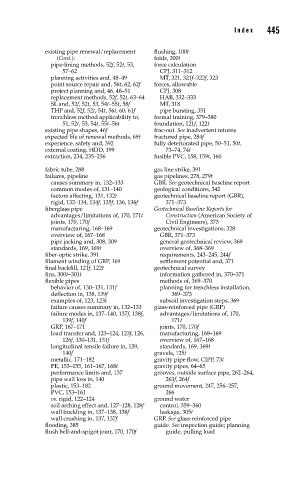Page 495 - Trenchless Technology Piping Installation and Inspection
P. 495
Index 445
existing pipe renewal/replacement flushing, 100t
(Cont.): folds, 300t
pipe-lining methods, 52f, 52t, 53, force calculation
57–62 CPJ, 311–312
planning activities and, 48–49 MT, 321, 321f–322f, 323
point source repair and, 56t, 62, 62f forces, allowable
project planning and, 46, 48–51 CPJ, 308
replacement methods, 52f, 52t, 63–64 HAB, 332–333
SL and, 52f, 52t, 53, 54t–55t, 58f MT, 318
THP and, 52f, 52t, 54t, 56t, 60, 61f pipe bursting, 351
trenchless method applicability to, formal training, 379–380
51, 52t, 53, 54t, 55t–56t foundation, 121f, 122t
existing pipe shapes, 46f frac-out. See inadvertent returns
expected life of renewal methods, 69t fractured pipe, 284f
experience, safety and, 392 fully deteriorated pipe, 50–51, 50t,
external coating, HDD, 199 73–74, 74t
extraction, 234, 235–236 fusible PVC, 158, 159t, 160
fabric tube, 288 gas line strike, 391
failures, pipeline gas pipelines, 278, 279t
causes summary in, 132–133 GBR. See geotechnical baseline report
common modes of, 131–140 geological conditions, 342
factors affecting, 131, 132t geotechnical baseline report (GBR),
rigid, 132–134, 134f, 135f, 136, 136f 371–373
fiberglass pipe Geotechnical Baseline Reports for
advantages/limitations of, 170, 171t Construction (American Society of
joints, 170, 170f Civil Engineers), 373
manufacturing, 168–169 geotechnical investigations, 328
overview of, 167–168 GBR, 371–373
pipe jacking and, 308, 309 general geotechnical review, 369
standards, 169, 169t overview of, 368–369
fiber-optic strike, 391 requirements, 243–245, 244f
filament winding of GRP, 169 settlement potential and, 371
final backfill, 121f, 122t geotechnical survey
fins, 300t–301t information gathered in, 370–371
flexible pipes methods of, 369–370
behavior of, 130–131, 131f planning for trenchless installation,
deflection in, 138, 139f 369–373
examples of, 123, 123t subsoil investigation steps, 369
failure causes summary in, 132–133 glass-reinforced pipe (GRP)
failure modes in, 137–140, 137f, 138f, advantages/limitations of, 170,
139f, 140f 171t
GRP, 167–171 joints, 170, 170f
load transfer and, 123–124, 123f, 126, manufacturing, 168–169
126f, 130–131, 131f overview of, 167–168
longitudinal tensile failure in, 139, standards, 169, 169t
140f gravels, 125t
metallic, 171–182 gravity pipe flow, CIPP, 73t
PE, 153–155, 161–167, 168t gravity pipes, 64–65
performance limits and, 137 grooves, outside surface pipe, 262–264,
pipe wall loss in, 140 263f, 264f
plastic, 153–182 ground movement, 247, 256–257,
PVC, 153–161 266
vs. rigid, 122–124 ground water
soil arching effect and, 127–128, 128f control, 359–360
wall buckling in, 137–138, 138f leakage, 305t
wall crushing in, 137, 137f GRP. See glass-reinforced pipe
flooding, 385 guide. See inspection guide; planning
flush bell-and-spigot joint, 170, 170f guide, pulling load

